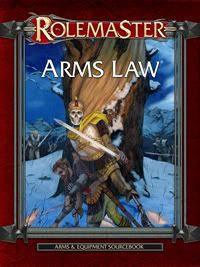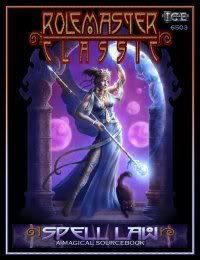
Did you know that the Rolemaster supplements were designed to supplement Classic D&D? Classic Dungeons and Dragons the grand daddy of all RPGs that is based either on pencil and paper, the computer (CRPGs and MMORPGs, is there such a thing as a Massively Multiplayer Online RolePlaying Game?), or Live Action (although Live Action roleplay has been existing for seven thousand years).
Classic D&D allowed you to do anything you put your imagination too. You want to fight a dragon, just make a cave, a dragon, and something you want that the dragon wants and has (like a princess). And go at it. There wasn't any thing complex to Classic D&D, and you just played it to your heart's content. There was nothing stopping you and your friends from having a good time.
However, along the way, several supplements were developed. Sometimes by third party publishers. One of these publishers was Iron Crown Enterprises. They developed three products that helped D&D play greatly, adding a sense of realism.
The first of these was Arms Law.

Arms Law brought to the table new rules on how to handle combat. Although the Weapon Mastery rules were wonderful in their own way, Arms Law brought realism to the fore of combat; introducing concussion hits, critical strikes, and what would happen if you were critically striked by a weapon or a claw. It came in two supplements: Arms Law and Claw Law. These were eventually merged into ARMS LAW, like you see on the left (which is the 2003 Revision).
This brought Classic D&D on a more dangerous level. Not only can your character die, but can die from a critical strike. Here's one infamous critical strike from said book:
Strike to foe's groin area. +10 hits. All vitals are destroyed immediately. Foe is stunned and unable to parry for 12 rnds and then dies.
That is the E critical Strike from the slashing table with a result of 100. That means any foe, of any level, can die instantly or after a period of time (ie. 12 rounds). This made playing D&D much more lethal to your character, but instantly more fun since it added the realism some players so craved.
 Not to be outdone, we have Spell Law. Besides adding rules for weapons, we have rules for spell casting; a lot of new spells to work with, and -- the happy Critical Strikes that such spells can cause.
Not to be outdone, we have Spell Law. Besides adding rules for weapons, we have rules for spell casting; a lot of new spells to work with, and -- the happy Critical Strikes that such spells can cause.So, not only can your character die by slashing hits, bludgeoning damage, crushing blows, and the Full Nelson, your character gets to be blown up -- and be blown up -- in style.
For instance, to quote the Fire Ball critical result table:
All that remains of foe are charred bits of teeth and bone. Add +20 to your next roll.
Doesn't sound like a walk in the park: for you or for your foe, right? But that is exactly what would happen if you cast a fireball spell at somebody! I refer you to the video above to see how dangerous fire can be if you don't believe me. Spell Law brought that kind of realism to the Classic D&D game.
 Finally, we come to the third installment to the series, Character Law. Character Law is designed to bring advanced character development to the Classic D&D game by allowing you to define what your character is capable of. This went so far as to define what your character knows: in terms of total basic knowledge that pertains to adventuring (hiding, swimming, running, etc.). The rest: such as where your character came from, how he got there and what he does on his spare time; was up to you.
Finally, we come to the third installment to the series, Character Law. Character Law is designed to bring advanced character development to the Classic D&D game by allowing you to define what your character is capable of. This went so far as to define what your character knows: in terms of total basic knowledge that pertains to adventuring (hiding, swimming, running, etc.). The rest: such as where your character came from, how he got there and what he does on his spare time; was up to you.So there you have it: Rolemaster is really a Classic D&D toolkit. These supplements enhanced everything pertaining to Classic D&D: weapon and combat rules, critical strikes, spell effects, and defining your character.
These concepts were eventually adapted into the D&D game little by little. Today, 4th Edition Dungeons and Dragons exist -- a game that has been influenced by ICE's game -- Rolemaster. Also, today, Rolemaster has evolved into a perfectly good game by itself. You can play Rolemaster by itself, or added to D&D. However, as for what Rolemaster has been designed, I suggest classic D&D.

3 comments:
The Rolemaster supplements were originally designed to plug into any system, offering more detailed combat and spellcasting options to any system, not just (A)D&D.
With the release of Character Law, Rolemaster became an excellent stand-alone system in it's own right. My own copy of the Arms Law & Claw Law (the third - I wore out two earlier Editions!) is the Fourth Edition dating back to 1984, and that (along with Character Law & Campaign Law and Spell Law) filled our gaming needs well into the '90s. It's a brilliant system that's fun to play, and combat is fast and brutally deadly.
There's no surprise the some of the influences of Rolemaster rubbed off on D&D game design - Monte Cook (he of 3rd Edition fame) cut his game designing teeth in the Iron Crown offices :D
Oh, I totally agree with you. Rolemaster is designed to be plugged into any system (I want to plug it in a lot of systems). But I wrote my post totally with those that play Classic D&D still.
I'm going for a classic D&D vein, lately. After all, your blog post has inspired me somewhat. :)
You know, they claimed that it was to be used with D&D but frankly, I've never found an actual bride between the systems. Does anyone know how to use Spell Law in place of D&D magic? By which I mean, without things like DP to buy spell lists, a whole category of magic items to make the low PP viable, or a number of other details...I just don't see how you can use it as written in place of a Wizard or Cleric's spells.
But if anyone has rules to do that, I'd love to see them!
Post a Comment